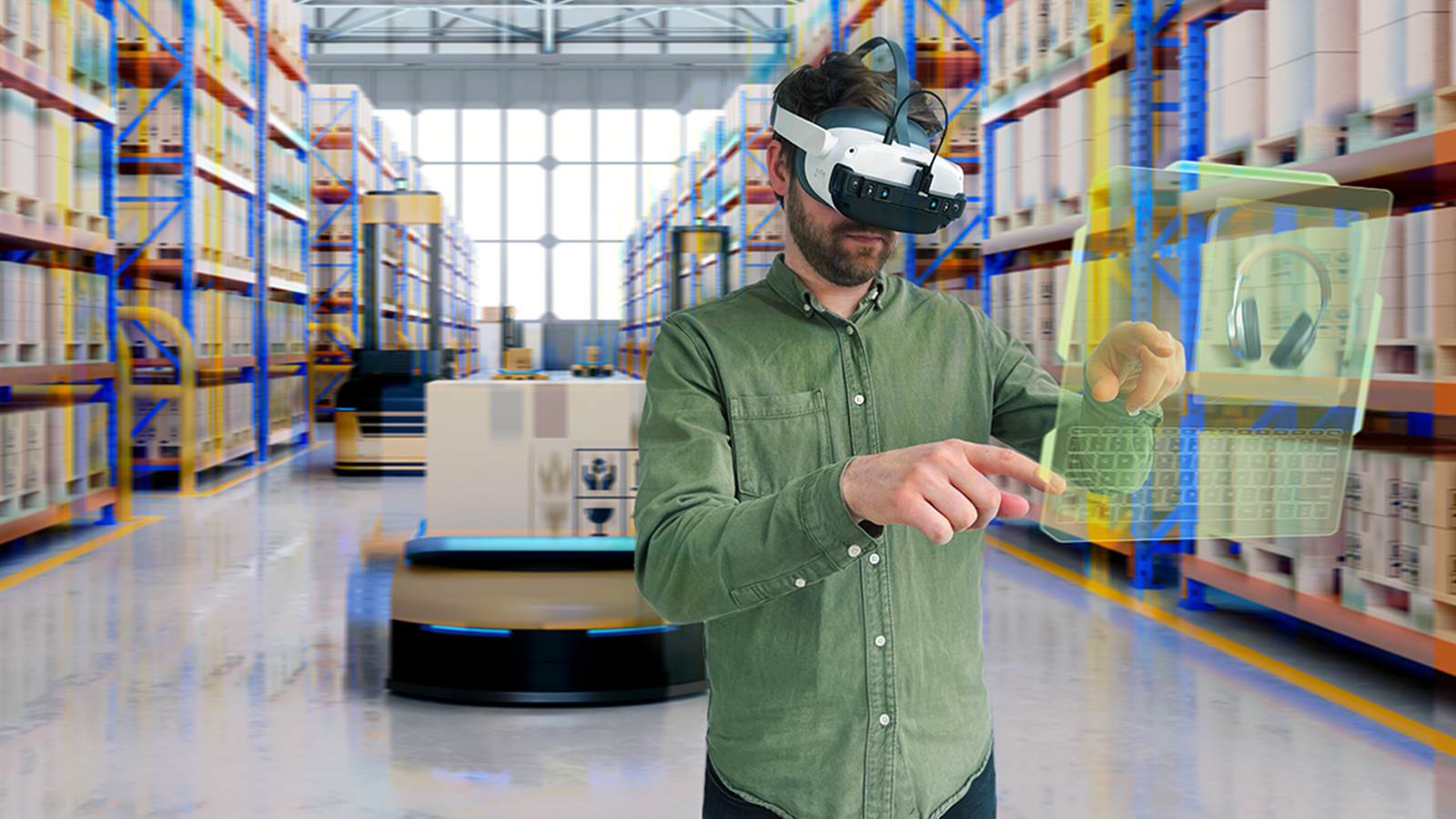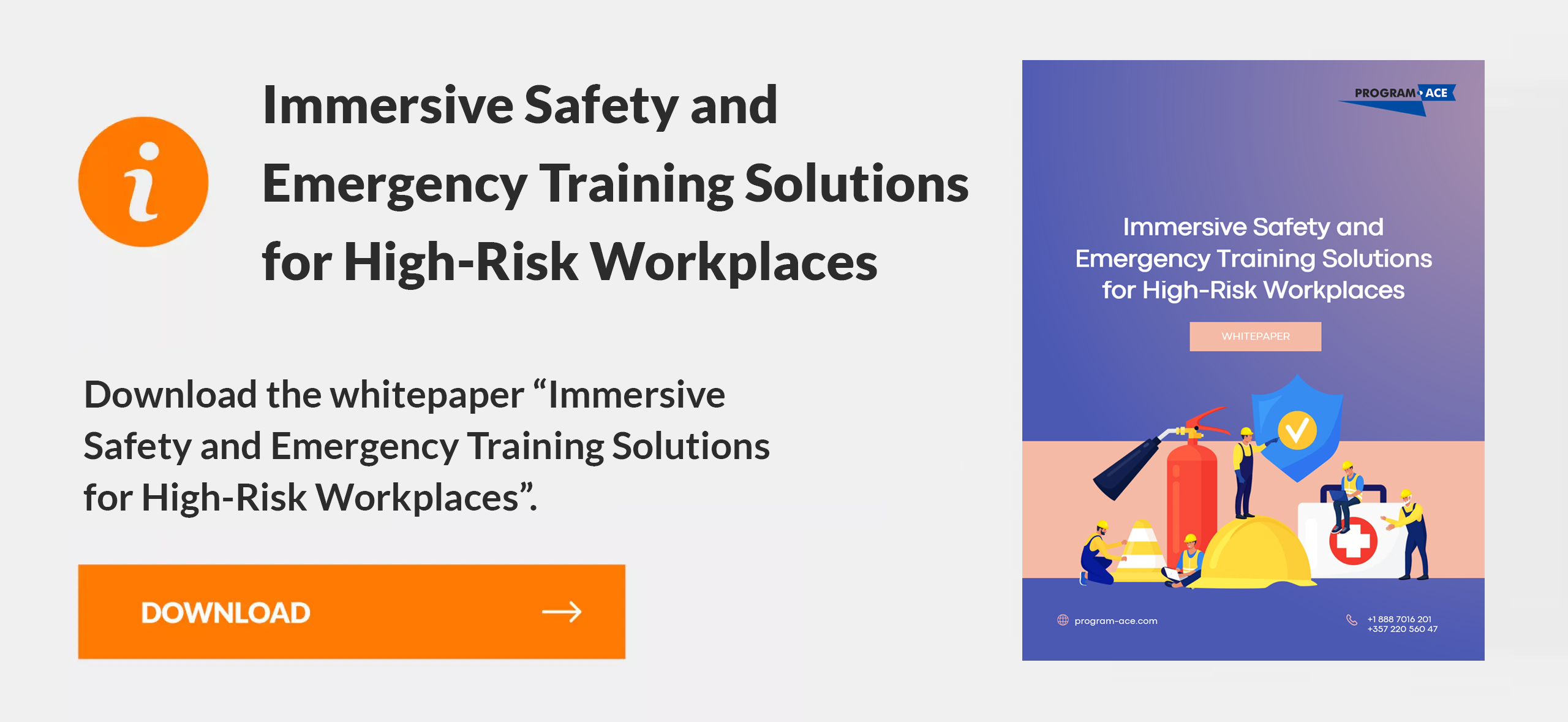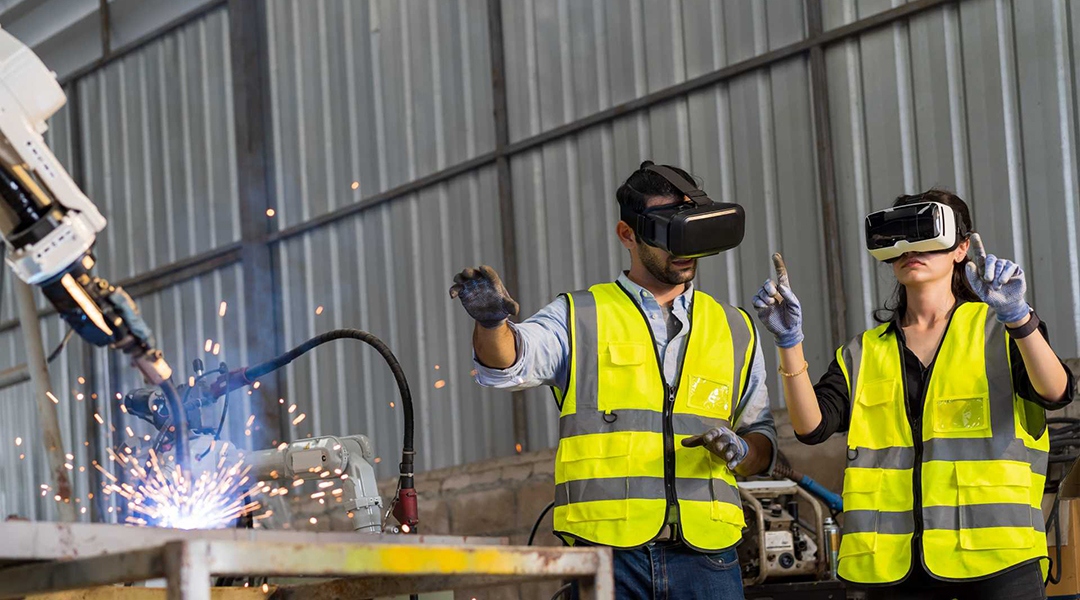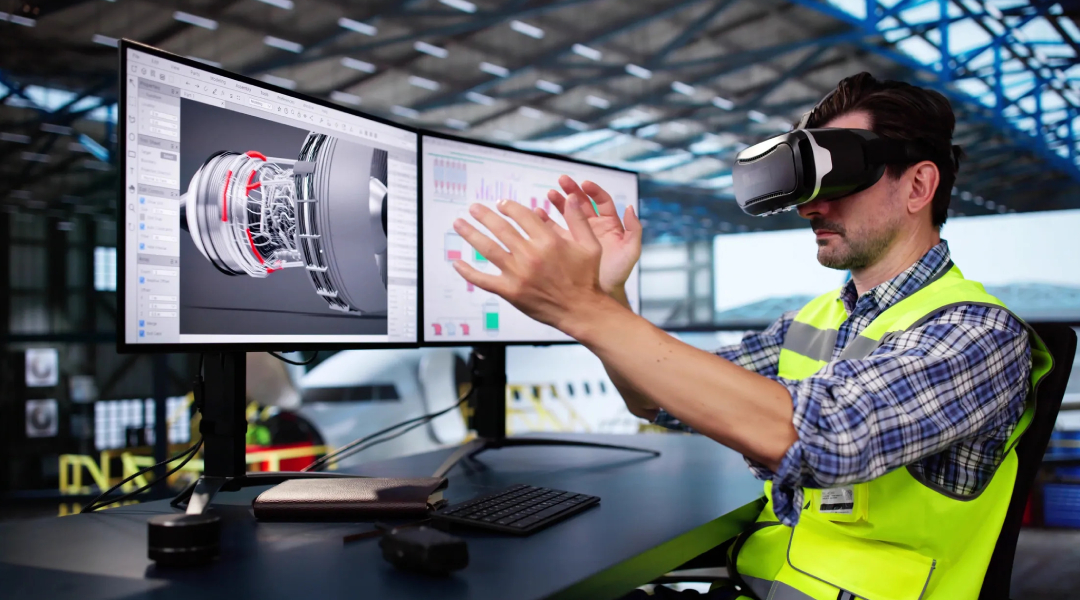Every virtual reality training company is aiming to transform warehouse workforce development by providing immersive and interactive learning experiences. These companies offer realistic simulations that allow employees to practice tasks in a safe and controlled environment. Workers can learn and refine skills without the risk of injury or damage to equipment, enhancing overall safety and efficiency. VR training helps in identifying and addressing skill gaps, leading to a more competent and confident workforce.
Companies can customize training programs to meet specific needs, ensuring that employees are well-prepared for their roles. The use of VR technology in training also facilitates better retention of information, as learners engage more actively with the material. With continuous advancements in VR technology, these training solutions are becoming more accessible and cost-effective, making them a valuable investment for companies aiming to improve their warehouse operations.
Introduction to VR Warehouse Training

Virtual training simulations are changing warehouse workforce development by offering practical, hands-on experiences without the risks associated with real-world training. Companies use these advanced technologies to create detailed, realistic environments where employees can practice and master various tasks. By integrating simulation training, organizations ensure that workers develop necessary skills in a safe, controlled setting.
Training simulations allow employees to encounter and solve potential challenges they may face in their daily operations. This method enhances problem-solving skills and boosts confidence. Customizable scenarios enable companies to tailor training to specific needs, improving efficiency and productivity.
The interactive nature of virtual training simulations promotes better retention of information, as employees engage actively with the content. Continuous improvements in VR technology make these training solutions more affordable and accessible, offering a cost-effective way to enhance workforce capabilities. As a result, companies see significant improvements in both employee performance and overall warehouse operations.
Virtual training simulation provides employees with a valuable opportunity to practice their tasks repeatedly until they achieve proficiency. This repetition is essential in ensuring that employees can handle their responsibilities effectively when they transition to their actual job roles. Companies that implement simulation training often see a reduction in errors and accidents, contributing to a safer work environment.
Moreover, virtual training simulations can be updated easily to reflect changes in warehouse procedures or new industry standards. This adaptability ensures that training programs remain relevant and up-to-date, providing employees with the most current knowledge and skills needed to excel in their roles.
By investing in virtual training simulations, companies can foster a culture of continuous learning and development, which ultimately leads to a more skilled and adaptable workforce. This approach not only enhances individual performance but also contributes to the overall success and competitiveness of the organization.
The Importance of VR Training in Warehouse Operations
VR training has become essential for warehouse operations because it offers realistic, hands-on learning experiences. Virtual training allows employees to practice tasks in a risk-free environment, leading to increased safety and efficiency. Workers can master their skills without fear of injury or equipment damage, enhancing overall productivity.
Virtual simulations provide an immersive experience where employees can tackle real-life scenarios. This approach helps identify and address skill gaps effectively, ensuring a competent workforce. Customized training modules cater to specific operational needs, making learning more relevant and impactful.
The use of virtual training also leads to better information retention. Interactive simulations engage employees more actively, resulting in improved learning outcomes. Additionally, VR training can be updated easily to keep pace with industry changes, ensuring that employees are always equipped with the latest skills and knowledge. Investing in VR training ultimately leads to a more skilled and adaptable workforce.
Common Challenges in Traditional Training
Traditional training methods in warehouse operations often fall short in preparing employees for real-world challenges. One major issue is the lack of hands-on experience. Training that relies heavily on lectures and written materials fails to provide practical skills, leaving employees unprepared for actual tasks. Theoretical knowledge cannot fully substitute for the experience gained through practice.

Another significant challenge is safety. Traditional training often involves on-the-job learning, which can expose employees to risks and hazards. New workers may make mistakes that lead to accidents or damage to equipment, compromising safety and incurring additional costs for the company.

Training consistency presents another problem. Different trainers may have varying approaches and levels of expertise, leading to inconsistent training quality. This inconsistency can result in a workforce with uneven skill levels, affecting overall operational efficiency.

Engagement also poses a challenge. Traditional methods often fail to keep employees interested and motivated, leading to poor information retention. Boredom and disengagement reduce the effectiveness of training programs.

Time constraints. Allocating sufficient time for comprehensive training without disrupting daily operations can be difficult.

Resource costs. The costs associated with materials, trainers, and potential downtime add up, making traditional training a less cost-effective solution.
Addressing these challenges requires a shift towards more practical training solutions, such as virtual simulations. Virtual training provides a safer, more engaging, and cost-effective alternative that better prepares employees for the demands of warehouse operations.
The Role of Technology in Addressing These Challenges
Technology plays a crucial role in overcoming the limitations of traditional warehouse training methods. As for digital twin vs. simulation, they both offer immersive, interactive experiences that bridge the gap between theoretical knowledge and practical skills.
- Digital twins. These virtual replicas of physical assets enable employees to interact with and understand complex systems in a safe, controlled environment. This approach reduces the risk of accidents and equipment damage.
- Simulation training. This method provides realistic scenarios where employees can practice and perfect their tasks. It allows for repeated practice without the fear of making costly mistakes, ensuring a higher level of proficiency and confidence among workers.
- Consistency. The technology ensures uniform training quality across the board. Digital training programs maintain a standard level of instruction, regardless of the trainer's expertise or approach, leading to a more uniformly skilled workforce.
- Engagement. Interactive digital training methods keep employees engaged, promoting better retention of information. Gamified elements and real-time feedback make learning more enjoyable and effective.
- Cost-efficiency. Implementing digital training solutions can reduce the long-term costs associated with traditional training methods. Reduced material usage, fewer trainer hours, and minimized downtime contribute to overall savings.
- Flexibility. Digital training programs can be updated easily to reflect changes in procedures or industry standards, ensuring that employees always have access to the latest information and skills.
Leveraging technology in training programs not only addresses the common challenges of traditional methods but also enhances the overall efficiency and effectiveness of workforce development.
What Is VR Warehouse Training All About?

VR warehouse training involves using virtual reality technology to create immersive, hands-on training experiences for employees. Unlike traditional methods, VR training provides a realistic environment where workers can practice tasks safely and effectively. The virtual training approach allows employees to learn and refine their skills without the risk of injury or equipment damage.
Real-life scenarios enable workers to face and solve challenges they might encounter on the job, ensuring they are well-prepared. Using VR in warehouse training enhances safety, improves skill retention, and provides a cost-effective solution for workforce development. This modern approach ensures that employees are competent and confident in their roles.
Overview of VR Technology
VR technology creates immersive, computer-generated environments that users can interact with using specialized hardware. Headsets, motion controllers, and haptic feedback devices enhance the realism of these environments, providing a lifelike experience. VR allows users to experience and manipulate 3D objects and spaces in a way that traditional screens and interfaces cannot.
Virtual training involves using VR to simulate real-world tasks and scenarios, enabling hands-on practice without real-world risks. This technology is vital for training in various fields, including warehouse operations. VR simulations provide a controlled environment where employees can learn and make mistakes safely, ensuring they gain practical skills and confidence.
Recent advancements in VR include higher-resolution displays, improved motion tracking, and more intuitive interfaces. These developments make VR more accessible and effective for various applications. The ability to update and customize VR environments ensures that training programs remain relevant and effective over time.
How VR is Applied in Warehouse Training
VR is applied in warehouse training to create realistic and interactive environments where employees can learn and practice tasks safely. This technology offers several key benefits:
- Enhanced safety. VR allows employees to practice high-risk tasks without any real-world danger, reducing the likelihood of accidents and injuries.
- Improved efficiency. Virtual training sessions can be repeated as often as necessary, allowing employees to master tasks at their own pace without disrupting warehouse operations.
- Cost-effectiveness. VR training can lower overall training costs by reducing the need for physical training materials and minimizing downtime.
- Better retention. Interactive and engaging VR simulations help employees retain information more effectively than traditional training methods.
- Customization. VR training programs can be tailored to the specific needs of a warehouse, addressing unique challenges and requirements.
Using VR in warehouse training ensures that employees are well-prepared for their roles. Virtual simulations provide hands-on experience with equipment and procedures, enhancing both competence and confidence. As VR technology continues to evolve, its applications in warehouse training are likely to expand, offering even more innovative and effective solutions for workforce development.
Benefits of VR Warehouse Training
VR warehouse training offers numerous advantages that enhance operational efficiency and employee performance. Virtual reality simulations create a risk-free environment for learning and practicing essential tasks, reducing the chances of accidents and equipment damage. By providing an engaging and interactive learning experience, VR training ensures better retention of information and skills.
Additionally, the flexibility of VR technology allows for the customization of training programs to address specific operational needs, ensuring that employees are well-prepared for their roles. Cost savings are another significant benefit, as VR training reduces the need for physical materials and minimizes downtime. Overall, implementing VR in warehouse training leads to a safer, more efficient, and well-equipped workforce.
Enhanced Learning and Retention
Virtual reality simulations significantly enhance learning and retention in warehouse training. Traditional training methods often struggle to engage employees, leading to poor information retention. In contrast, VR provides an immersive learning experience that captures attention and maintains interest.
- Active engagement. VR requires employees to interact with the training material, fostering a deeper understanding. This active involvement helps in retaining information longer than passive learning methods.
- Realistic scenarios. VR simulations replicate real-world tasks and challenges, allowing employees to practice and learn in a lifelike environment. Experiencing these scenarios firsthand makes the learning process more impactful and memorable.
- Repetition and practice. Employees can repeat VR training sessions as needed, ensuring they master the required skills. This repetition builds confidence and competence, preparing employees for real-world tasks.
- Immediate feedback. VR training provides instant feedback, allowing employees to correct mistakes and improve their performance on the spot. This immediate reinforcement of correct behaviors accelerates the learning process.
- Customized learning paths. VR technology allows for the creation of personalized training programs tailored to individual needs and skill levels. This customization ensures that each employee receives the appropriate level of challenge and support.
Improved Safety Measures
When it comes to virtual reality simulations, there’s no denying that it helps enhance safety measures in warehouse operations. Training employees in a virtual environment eliminates the risks associated with on-the-job learning, leading to a safer workplace.
- Risk-free practice. Employees can practice high-risk tasks in a controlled virtual setting without the danger of injury or damage. This approach allows workers to gain experience and confidence before performing tasks in the real world.
- Error reduction. VR training helps employees identify and correct potential mistakes in a safe environment. Reducing errors in the virtual world translates to fewer accidents and incidents in the workplace.
- Safety protocols. VR simulations can include safety drills and emergency response training, ensuring that employees are well-prepared for unexpected situations. Practicing these protocols in a virtual setting reinforces their importance and effectiveness.
- Equipment handling. Employees can learn to operate machinery and equipment in VR, minimizing the risk of mishandling or misuse. This training ensures that employees are familiar with the equipment before using it in real-world operations.
- Ongoing safety updates. VR training programs can be easily updated to reflect new safety regulations and best practices. Continuous updates ensure that employees are always aware of the latest safety standards and procedures.
Cost-Effectiveness of VR Training
Implementing VR training in warehouse operations offers significant cost savings compared to traditional training methods. Virtual reality simulations reduce the need for physical materials and minimize downtime, making it a cost-effective solution.
- Reduced training materials. VR training eliminates the need for printed manuals, training props, and other physical materials. All training content is delivered digitally, reducing costs associated with producing and maintaining these materials.
- Minimized downtime. Traditional training often requires halting operations, leading to lost productivity. VR training can be conducted without disrupting daily operations, allowing employees to learn while maintaining workflow efficiency.
- Fewer accidents. Training in a virtual environment reduces the likelihood of workplace accidents and associated costs. Fewer injuries mean lower medical expenses and reduced workers’ compensation claims.
- Scalable solutions. VR training programs can easily be scaled to accommodate a large number of employees without significant additional costs, making them a cost-effective option for large organizations.
- Long-term savings. Investing in VR technology may have upfront costs, but the long-term savings from reduced training materials, fewer accidents, and improved efficiency outweigh the initial investment. Continuous updates and improvements to VR training programs ensure ongoing cost-effectiveness.
Overall, VR training provides a comprehensive and cost-effective approach to workforce development, enhancing safety, efficiency, and employee performance in warehouse operations.
Implementation Strategies for VR Warehouse Training
Implementing VR warehouse training requires careful planning and strategic execution. Begin by thoroughly understanding the specific training needs of warehouse staff. This involves assessing current skill levels, identifying gaps, and determining the most relevant training modules. Conducting a detailed analysis of operational challenges and consulting with managers can provide valuable insights into the training requirements. Selecting the right VR equipment and software is crucial for a seamless training experience. Ensure that the chosen technology is compatible with existing systems and easy for employees to use. Integration with current workflows is essential for consistency and efficiency.
A phased implementation approach can be effective. Start with a pilot program to test the VR training modules and gather feedback from participants. Use this feedback to make necessary adjustments before rolling out the program on a larger scale. Providing comprehensive training for staff on using the new VR equipment and software is vital. Continuous monitoring and evaluation of the VR training program help ensure its effectiveness and allow for ongoing improvements. Proper implementation strategies will enhance the success of VR training programs, improving both skills and safety in warehouse operations.
1. Assessing Training Needs
Assessing training needs is a critical step in implementing VR warehouse training. Begin by analyzing current operational challenges and identifying areas where employees lack proficiency. Conducting surveys and interviews with staff can provide valuable insights into their training requirements. Reviewing past incidents and performance metrics helps pinpoint specific skills that need improvement. Collaborate with managers and team leaders to understand the practical aspects of daily operations and the skills essential for efficiency.
A comprehensive assessment involves multiple methods. Observing employees during their tasks can highlight common errors and areas needing improvement. Employee feedback sessions can uncover specific challenges they face and suggest potential training topics. Additionally, examining the outcomes of previous training programs can reveal gaps in current training methodologies. Use the gathered data to create a detailed training needs report. This report should outline key areas for development, specific skills required, and the desired outcomes of the training program.
Sharing this report with stakeholders ensures everyone is aligned on the training objectives. This thorough assessment ensures that the VR training program addresses the most relevant and impactful areas, leading to improved performance and safety in the warehouse. Tailoring the training content to specific needs guarantees more effective and engaging learning experiences for employees.
2. Choosing the Right VR Equipment and Software
Selecting the appropriate VR equipment and software is vital for effective warehouse training. Start by evaluating the specific tasks and scenarios that the training will cover. High-quality VR headsets with accurate motion tracking enhance the realism of the training experience, making it more immersive and compelling. The software should offer customizable modules that can be tailored to the unique needs of the warehouse, ensuring relevance and effectiveness.
Compatibility with existing systems is crucial. The chosen VR equipment and software must integrate seamlessly with the warehouse's current technological infrastructure. This integration facilitates a smooth transition to VR training and minimizes disruptions. Prioritize user-friendly interfaces that are easy for employees to navigate, reducing the learning curve and increasing adoption rates.
Consider the long-term support and updates provided by the VR solution vendors. Regular updates ensure the training content remains current and effective, reflecting the latest industry standards and practices. Strong customer support can address any technical issues quickly, minimizing downtime and ensuring continuous training.
Investing in the right VR technology involves evaluating various vendors, comparing features, and possibly conducting trials to determine the best fit for the warehouse's needs. Choosing solutions with robust customer support and regular updates keeps the training program current and effective. This investment ensures that employees receive high-quality training, enhancing their skills and confidence in performing tasks.
3. Integrating VR Training with Existing Systems
Integrating VR training with current warehouse systems allows for a smooth transition and leverages the benefits of the new training strategy. Begin by sketching out the present training procedures and determining how VR modules may complement and improve them. Work closely with the IT and operations teams to ensure the VR system seamlessly integrates with current software and hardware. This collaboration is critical for resolving technical issues and assuring compatibility.
Data from VR training sessions should be readily available and compatible with existing monitoring and reporting technologies. This compatibility enables detailed analysis and monitoring of employee growth, as well as the training program's efficacy. Ensure that VR training data may be connected with current HR and performance management tools to improve overall training program management.
Provide extensive staff training on how to operate the new VR equipment and software. This training should address not only the technical elements of utilizing the VR equipment but also the goals and advantages of the VR training program. Ensuring that employees understand the benefits of VR training boosts engagement and adoption.
Continuous assessment and feedback are required for a successful integration. To identify areas for improvement, conduct regular reviews of the VR training program's influence on employee performance and solicit participant input. Adjusting the VR training modules based on this input guarantees that the training is still relevant and practical. The successful integration of VR training into current systems improves the whole training program, making it more effective and unified. This strategy improves warehouse performance, safety, and efficiency.
Case Studies and Real-World Examples
Virtual reality training has significantly benefited various industries, including warehousing. One prominent example is Amazon's implementation of VR training to enhance safety and efficiency in its warehouses. Amazon's VR program focuses on training employees to interact safely with their advanced robotics systems. The immersive training allows workers to practice scenarios such as safely entering the robotics floor and performing maintenance tasks without real-world risks, significantly reducing accidents and enhancing overall operational efficiency.
Another compelling case is from Nestlé Purina, which uses VR for retail shelf planning and factory tours. By creating virtual tours of their production facilities, Nestlé Purina allows salespeople to understand the production process better, leading to better client interactions and increased trust. The VR training modules also include retail shelf planning, where sales data is used to optimize shelf displays in a virtual environment before applying the changes in actual stores.
Intel has also leveraged VR technology for electrical safety recertification. The VR training program developed by Intel has demonstrated a remarkable return on investment (ROI) of 300% over five years. This program allows employees to engage in risk-free simulations of electrical safety protocols, significantly improving safety compliance and reducing training costs.
Walmart has used VR to prepare employees for high-stress scenarios like Black Friday. VR training helped store managers reduce total training time, enabling them to handle large customer volumes more effectively. The success of this program has led Walmart to expand VR training to 200 training centers nationwide.
These examples illustrate the diverse applications and benefits of VR training across different sectors. From improving safety and operational efficiency in warehouses to enhancing customer service and sales processes, VR training provides a versatile and effective solution for modern workforce development. For more details on these case studies, you can visit the sources VirtualSpeech, Roundtable Learning, and Axon Park.
Future Trends in VR Warehouse Training
The future of VR warehouse training is set to become increasingly sophisticated and integrated with advanced technologies. One significant trend is incorporating artificial intelligence (AI) to personalize training experiences. AI can analyze an employee's performance and adapt training modules to focus on areas needing improvement, ensuring a more efficient learning process.
Another emerging trend is the use of haptic feedback technology. This technology provides tactile sensations to users, allowing them to feel virtual objects and interactions. Haptic feedback enhances the realism of VR training, making it more effective for tasks requiring precise hand movements, such as equipment handling and assembly processes.
The integration of VR training with augmented reality (AR) is also on the rise. Combining VR and AR allows for a more flexible training approach, where employees can switch between fully immersive environments and augmented real-world scenarios. This hybrid model can cater to various training needs and environments. Additionally, advancements in cloud computing will play a crucial role. Cloud-based VR platforms will enable easier updates and scalability, allowing companies to efficiently deploy and manage VR training programs across multiple locations. This approach reduces costs and ensures consistency in training quality.
Moreover, the development of portable VR devices will make training more accessible. Lightweight, wireless headsets will allow employees to engage in VR training without being tethered to a specific location, providing more flexibility and convenience. Finally, the gamification of VR training is expected to become more prevalent. By incorporating game-like elements such as scores, levels, and rewards, VR training can increase employee engagement and motivation, leading to better learning outcomes.
Embracing the Future of VR Warehouse Training with Program-Ace
Program-Ace offers cutting-edge VR warehouse training solutions that significantly enhance safety and operational efficiency. As an experienced software development service provider, we specialize in creating tailored VR training programs incorporating advanced technologies such as AI, haptic feedback, and cloud-based platforms. Our solutions provide immersive, hands-on experiences that effectively develop the skills your employees need.
By choosing Program-Ace, you ensure your workforce is well-prepared to handle real-world challenges confidently and competently. Our VR training programs are customizable to meet your specific operational needs, leading to improved performance and reduced risks.
Ready to transform your warehouse training with the latest VR technology? Contact us now to discuss how we can develop a bespoke VR training program for your organization. Enhance your training effectiveness and stay ahead in the industry with Program-Ace.




























